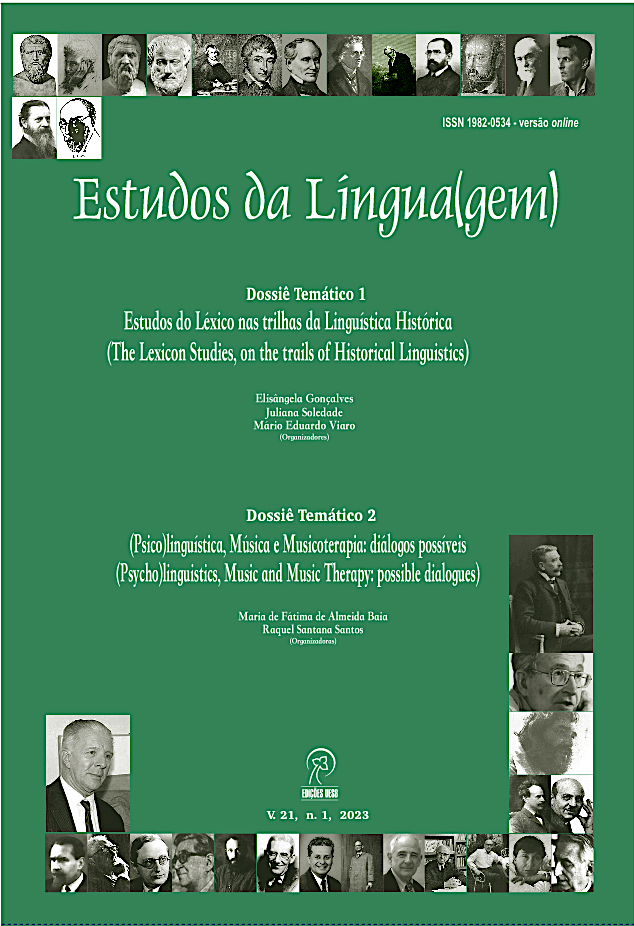Desenredando fios da fala e do canto infantis: diferentes matizes da mesma cor (Unraveling threads of children's speech and singing: different shades of the same color)
DOI:
https://doi.org/10.22481/el.v21i1.13373Palavras-chave:
Aquisição do canto; Fala; Desenvolvimento vocal; Análise acústica; Primeira infância.Resumo
Fala e canto são duas funções comunicativas humanas que partilham processos cognitivos e neurais e cuja inter-relação sempre interessou investigadores de ambas as áreas. No entanto, são poucos os estudos que comparam as vocalizações obtidas naqueles dois contextos, sobretudo em bebés e crianças em idade pré-escolar. A presente investigação acompanhou o desenvolvimento da voz cantada de crianças durante o segundo ano de vida, a partir de duas condições distintas – Conversa e Canção. As características segmentais, melódicas e rítmicas das vocalizações obtidas foram analisadas acusticamente. Os resultados evidenciaram diferenças significativas nas vocalizações obtidas em função das duas condições experimentais, nomeadamente ao nível da duração das vocalizações e da extensão vocálica das mesmas. Tal poderá revelar que há uma distinção precoce entre a voz cantada e a falada. São ensaiadas reflexões relativas ao papel da aculturação e educação musicais precoces, sugerindo pistas para futuras investigações nesta área.
Downloads
Referências
ADACHI, M., & TREHUB, S. E. Musical lives of infants. In: MCPHERSON, G. & WELCH, G. (Eds.). The Oxford handbook of music education. New York: Oxford University Press, 2012, p. 229-247.
BERGESON, T. R., & TREHUB, S. E. Signature tunes in mothers' speech to infants. Infant Behavior and Development, 30, p. 648-654, 2007.
BERTONCINI, J., FLOCCIA, C., NAZZI, T., & MEHLER, J. Morae and syllables: Rhythmical basis of speech representations in neonates. Language and Speech, 38(4), p. 311–329, 1995.
BOERSMA, P., & WEENINK, D. Praat: Doing phonetics by computer (Version 4.4.04) [software]. Disponível em: http://www.praat.org/. Acesso em: 3 de novembro de 2021
COSTA-GIOMI, E., & ILARI, B. Infants’ preferential attention to sung and spoken stimuli. Journal of Research in Music Education, 62(2), p. 188–194, 2014.
DOWLING, W. J. The development of music perception and cognition. In: DEUTSCH, D. (Ed.), The psychology of music. San Diego: Academic Press. 1999, p. 603-625.
FOX, D.B. The pitch range and contour of infant vocalization. Peter Costanza. 1982. Dissertação de Doutoramento em Educação Musical. Ohio State University.
GORDON, E. Teoria de aprendizagem musical. Competências, conteúdos e padrões. Tradução por Maria de Fátima Albuquerque. Lisboa: Fundação Calouste Gulbenkian, 2000.
LEVINOWITZ. L., BARNES, P., GUERRINI, S., CLEMENT, M., D'APRIL, P. & MOREY, M. Measuring Singing Voice Development in the Elementary General Music Classroom. Journal of Research in Music Education. 46(1), p. 35-47, 1998.
LONGHI, E. ‘Songese’: Maternal structuring of musical interaction with infants. Psychology of Music, 37, p. 195–213, 2009.
MOOG, H. The musical experience of the pre-school child. London: Schott, 1976.
NAKATA, T., & TREHUB, S. E. Infants’ responsiveness to maternal speech and singing. Infant Behavior & Development, 27, p. 455–464, 2004.
PAPOUŠEK, M. Intuitive parenting. In: DELIÈGE, I.; SLOBODA, J. (Eds.). Musical beginnings: Origins and development of musical competence. Oxford: University Press, 1996, p. 88-112.
PATEL, A. Music, language, and the brain. New York: Oxford University Press, 2008.
REIGADO, J., ROCHA, A., & RODRIGUES, H. Vocalizations of infants (9–11 months old) in response to musical and linguistic stimuli. International Journal of Music Education, 29(3), p. 241–255, 2011.
SALSELAS, I., & HERRERA, P. Music and speech in early development: Automatic analysis and classification of prosodic features from two Portuguese variants. Journal of Portuguese Linguistics, 9(10), p. 11–36, 2011.
SCOTTO DI CARLO, N. Contraintes de production et intelligibilité de la voix chantée. Travaux Interdisciplinares du Laboratoire Parole et Langage, 24, p. 159–179, 2005.
STALINSKI, S., & SCHELLENBERG, E. G. Shifting perceptions: Developmental changes in judgments of melodic similarity. Developmental Psychology, 46(6), p. 1799–1803, 2010.
TAFURI, J., & VILLA, D. Musical elements in the vocalizations of infants aged 2–8 months. British Journal of Music Education, 19(1), p. 73–88, 2002.
TREHUB, S. E., & GUDMUNDSDOTTIR, H. R. Mothers as singing mentors for infants. In: WELCH, G.; HOWARD, D.; & NIX, J. (Eds.). The Oxford handbook of singing. Oxford: Oxford University Press, 2015, p. 455-469
TREHUB, S., & HANNON, E. Conventional rhythms enhance infants’ and adults’ perception of musical patterns. Cortex, 45, p. 110–118, 2009.
TREHUB, S. E., & THORPE, L. A. Infants’ perception of rhythm: Categorization of auditory sequences by temporal structure. Canadian Journal of Psychology, 43, p. 217–229, 1989.
Downloads
Publicado
Como Citar
Edição
Seção
Licença

Este trabalho está licenciado sob uma licença Creative Commons Attribution 4.0 International License.
Autores que publicam em Estudos da Língua(gem) concordam com os seguintes termos:
Estudos da Língua(gem) mantém os direitos autorais das contribuições publicadas e disponibiliza seu conteúdo gratuitamente por meio do portal. Autores têm permissão e são estimulados a publicar e distribuir seu trabalho online em repositórios institucionais ou na sua página pessoal, com reconhecimento de autoria e créditos de publicação inicial nesta revista, indicando endereço online.






